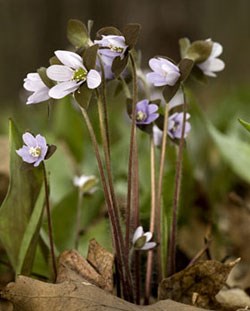
IntroductionThe leaves are three-lobed, leathery and lay close to the ground. The leaves are also green throughout the year, although they tend towards brownish/green for much of the year. The beautiful lavender, pink, or whitish flowers, at the end of 3-6” stems, emerge from the leaf litter early in the year before leaves on the forest canopy began to block the sunlight. The hepaticas and other spring ephemeral flowers finish blooming when sunlight is blocked by developing leaves in the forest canopy. There are two hepatica species in our area. They can be differentiated by looking at the tips of the leaf lobes. The round-lobed hepatica have, as their name implies, rounded tips on the leaf lobes while the lobes on the sharp-lobed hepatica end in a point. Blooms: April and May Fascinating Facts
Find ItWant to Help Us Better Understand the Park?See our iNaturalist project, "The Life of the Mississippi National River and Recreation Area" and contribute to it by downloading the iNaturalist app and uploading your sightings of this species, and others, to the project. You can also upload your sightings from your computer. |
Last updated: March 7, 2018
